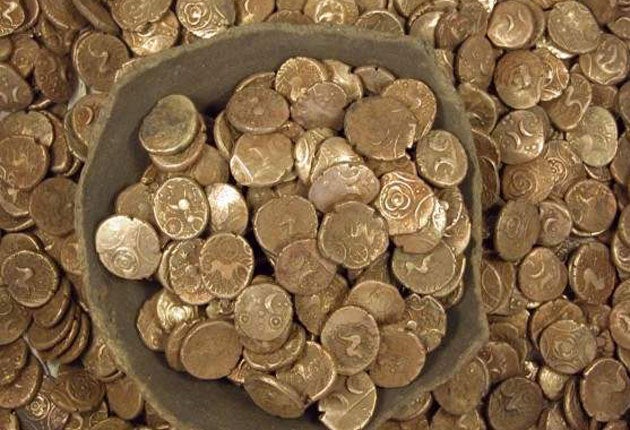Boudicca's gold hoard unearthed

The largest hoard of prehistoric gold coins in Britain in modern times has been discovered by a metal detectorist in East Anglia.
The 824 gold staters, worth the modern equivalent of up to £1m when they were in circulation, were in a field near Wickham Market, Suffolk. Almost all the coins were minted by royal predecessors of Boudicca, the warrior queen of the Iceni tribe who revolted against Rome in AD 60.
The solid gold staters – each weighing just over 5g – were made between 40BC and AD 15, most of them in the final 35 years of that period. They were buried in a plain pottery vessel, possibly inside a rectilinear religious compound, between 15 and AD 20.
Although it has not yet been proved, it is likely the hoard represented part of the wealth of an individual or community and was buried as a votive offering at a time of a political stress, drought or other natural disaster.
This is the first major Icenian gold coin hoard found but the tribe had a tradition of making votive offerings of other gold objects. At one of their major religious centres, Snettisham in northern Norfolk, the tribe buried at least 30kg of gold and silver jewellery. also within a rectilinear enclosure.
The discovery is important because it highlights the probable political, economic and religious importance of an area on the southern fringe of Icenian territory, near its border with the Trinovantian tribal kingdom.
The Wickham Market area seems to have been of great importance in Iron Age times. Within a few miles of the spot where the coins were found are two other important sites.
“The [new] hoard is absolutely unique,” said Ian Leins, the British Museum’s curator of Iron Age coins. “It is the largest hoard of British Iron Age gold coins to be studied in its entirety.”
The find is the most substantial Iron Age gold coin hoard found in Britain since 1849, when a farm worker unearthed between 800 and 2,000 gold staters in a field near Milton Keynes.
To protect the site, archaeologists from Suffolk County Council kept the discovery under wraps for months while they made secret excavations, funded by the British Museum. The area was thoroughly searched to ensure that all of the coins had been found before the discovery was announced to the public.
Join our commenting forum
Join thought-provoking conversations, follow other Independent readers and see their replies
Comments
Bookmark popover
Removed from bookmarks